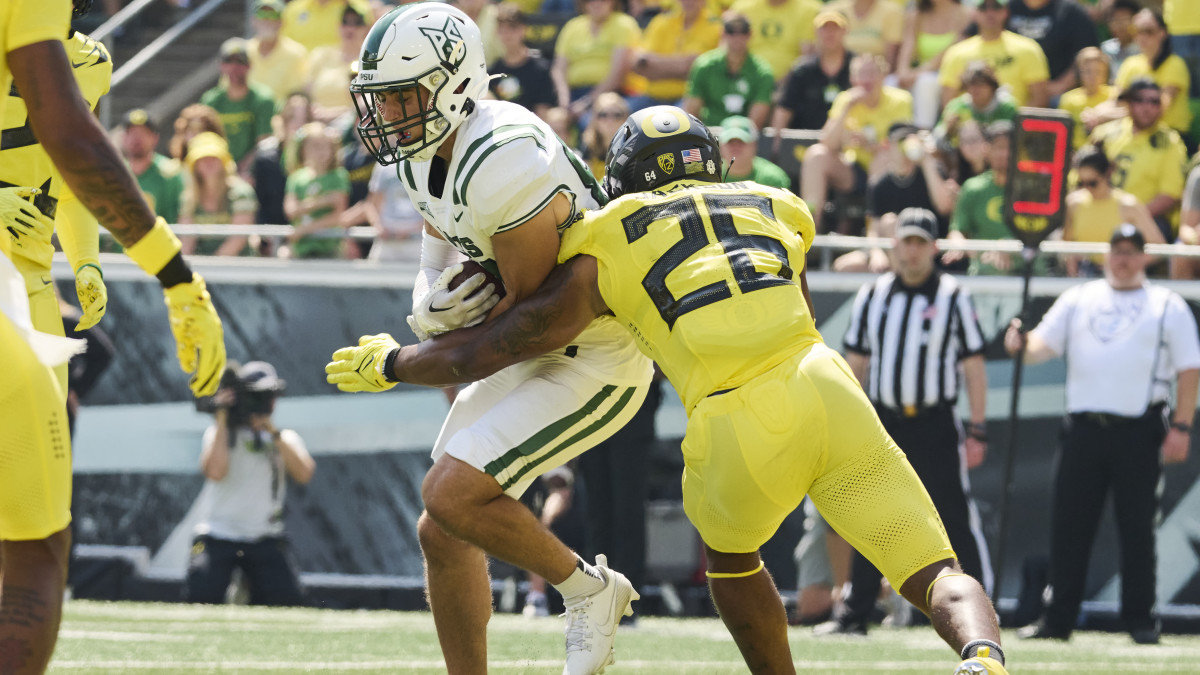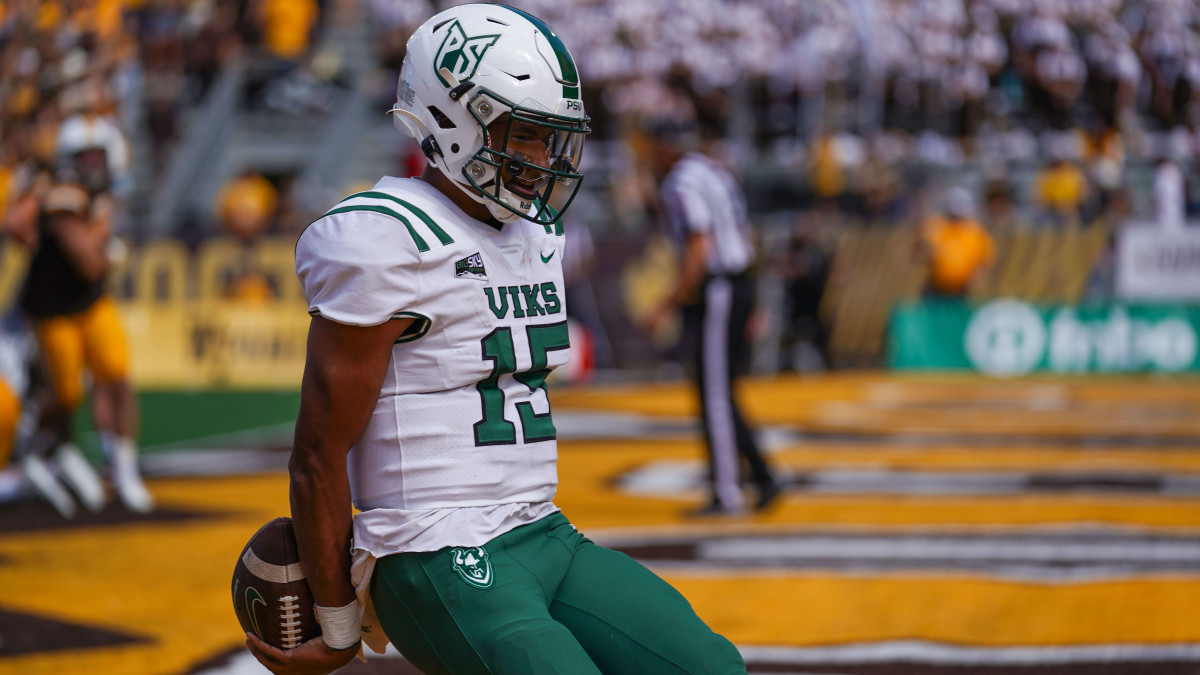Money Talks in College Football, Just Ask Portland State

You may not ever see a more jarring three-game stretch than what Portland State has just been through. Sandwiched around a 31–17 loss to Wyoming in Week 2 was a Week 1 loss to in-state foe Oregon, 81–7, and a 91–0 blowout over North American, based in Texas. The Vikings improbably ended their non-conference slate with a +3 point differential, and their two most eye-popping results tell a clear story about the economics of college sports and how things trickle down from the highest rungs of the ladder to the lowest.
Portland State played Oregon in Eugene and earned around $600,000 for their troubles (which they were able to take home more of because it was a game that didn’t involve cross-country travel). It’s a significant portion of the school’s $15 million annual athletic budget. By comparison, the Ducks have an athletics budget of around $150 million. They needed someone to come play them for an early-season warmup, and shelling out $600,000 for a “buy game” is standard operating procedure for a program of their size.
Oregon is in the Football Bowl Subdivision (FBS) of Division I, and Portland State is in the Football Championship Subdivision (FCS). The most significant distinctions are that the NCAA runs the FCS postseason while the FBS is run by the bowls and the College Football Playoff. FBS and FCS also have different scholarship requirements (85 full scholarships versus 63 total scholarships that can be divided up between athletes).
Watch college football with Fubo. Start your free trial today.
“You’ve got to play those games to put resources in your programs so you can grow your program,” Portland State AD John Johnson says. “But that’s one of the quickest and easiest ways to do it other than getting playoffs and, you know, winning, but that helps pay the bills for not football necessarily, but for the rest of our programs that aren’t revenue generating by nature.”

So how did Portland State end up on the winning side a couple weeks later of such a lopsided score? Johnson started the job a little over a year ago and encountered an issue from Day 1: a hole in his football schedule. Typically football games are scheduled far in advance (case in point, Johnson says Portland State’s non-conference slate is almost completely full through 2029). But a team dropped out for this year’s schedule, and without much time, the Vikings worked with a third-party scheduler to come up with an opponent who could guarantee a home game, with all the revenue it provides. In February, which is considered very late, they found a team to make it work, but it was from the National Association of Intercollegiate Athletics (NAIA). Just as Portland State accepted a big payday to send their football team against a vastly superior opponent, now the school would offer cash—$75,000—to a team similarly inferior to its Vikings, but just as eager for the loot.
There are two other divisions in the NCAA: Divisions II and III. Then there is the NAIA, where football teams can offer 24 scholarships max, which can be divided up in fractions between athletes. The NAIA’s value proposition boils down to its pitch that it is cheaper to be involved with it than the NCAA, and therefore better for schools’ bottom lines.
There are a handful of NAIA vs. NCAA games in each of the NCAA’s three divisions. Of Division I teams, only FCS teams play NAIA schools, and they do it sparingly. FCS versus FBS games happen very often, and there are few, if any, FBS schools that have not scheduled an FCS opponent at some point in their recent history.
The 91–7 victory represented the third most points in Portland State history (the school previously set a FCS scoring record with a 105–0 win over Delaware State in 1980). Against North American, there was no running clock, although Portland State played most of their roster. According to a game recap on the school’s website: “Among PSU’s 91 participants, nine different players scored touchdowns for the Vikings, 10 different players carried the ball and 34 different players had tackles during the game. The Vikings threw only 12 passes overall, completing eight for 134 yards and four touchdowns. PSU rushed 46 times for 285 yards and seven touchdowns.” It was the school’s first shutout victory since 2019, and they held North American to -23 yards of total offense and -49 rushing yards total. The game went to halftime at 63–0. In total, they scored 11 offensive touchdowns.
“Great opportunity for us to be able to get back into our program, as far as the financial benefits that come from it,” North American athletic director/head coach Kenneth Apande says. “We also looked at it as a great opportunity for the kids to get an experience and their experience on a top level from traveling. And you know, as far as what the game day situation is, small schools don’t really get that opportunity to do that.”
Appande has no issue with how the game was managed. The Vikings ran the play clock down to zero once the game was not in doubt, and mostly ran the ball to shorten the game. Football comes with significant safety concerns when teams are at the same level, not to mention when one is significantly outmatched. Appande says they took two athletic trainers with them, and Portland State supplied some trainers as well. Appande says he has six full-time assistant coaches, a couple contractors and a couple student coaches on his staff.
“This past week, we probably had seven injuries,” Appande says. “Thank God they weren’t anything major. Of course I don’t want any of my kids to get hurt, but they were all minor injuries. We’re hoping that we can sustain and play hard and compete [next week]. That’s all I care about is competing and not giving up.”

He calls the program a startup, which began in 2020 after three years of building recruiting classes largely through the National College Scouting Association recruiting service and showcase events that connect high school athletes and coaches. It also helps that the school is based in Houston. There typically isn’t that much difference in talent between NAIA schools and bottom-rung Division II or Division III programs.
The school is an associate member of the NAIA as of July 2022, as it is in the process of securing accreditation as an institution. It is not eligible for the postseason nor does it have voting rights at the NAIA level yet.
North American does not have its own permanent facilities, but Appande says he rents a mix of facilities in the Houston area including Dulles High School, Old Kempner Stadium and Rice University. They have a JV program as well for a roster size of about 150 when the school year started.
He says it’s tough to manage morale after a loss of this nature. There’s a chance there will be another such loss against Incarnate Word (a 2022 FCS semifinalist) next weekend. The program will make a little bit more for that game, and it’s close enough in San Antonio for the team to bus rather than fly halfway across the country to Oregon.
For Portland State, a member of the Big Sky Conference, the game does not count toward their postseason eligibility. A typical FCS season is 11 games, ending the week before Thanksgiving, when the postseason starts. That can be 12 in certain years when the calendar falls the right way, or under certain NCAA bylaw exemptions.
The Big Sky Conference prefers for their teams’ schedules to include one Power 5 so-called guarantee game, similar to the one Portland State played against Oregon with a payout. Then eight conference games, and one non-conference home game and one non-conference away game with an FCS opponent. A school like Montana or North Dakota State might be able to swing a home-and-home series with an FCS team, but for a school like Portland State, it can be difficult to miss out on the lost home-game revenue in Year 2 of such an arrangement. The Big Sky as a conference does not have to approve non-conference opponents its teams play, and encourages its schools to play NCAA opponents.
“You balance it between generating revenue and having home games to generate interest and money,” Johnson says. “So you can’t go on the road all the time, because you need to get some home games. And then you have your league schedule. You vet who they are, you knew they weren’t an established program. But I’ve also, you know, if you look at FCS and even in our league there’s been every year at least one or two teams [that] play NAIA programs. That’s not uncommon.”
Money talks in college sports, and for Portland State it tells the story of a non-conference schedule that spans the full spectrum of athletic resources.
